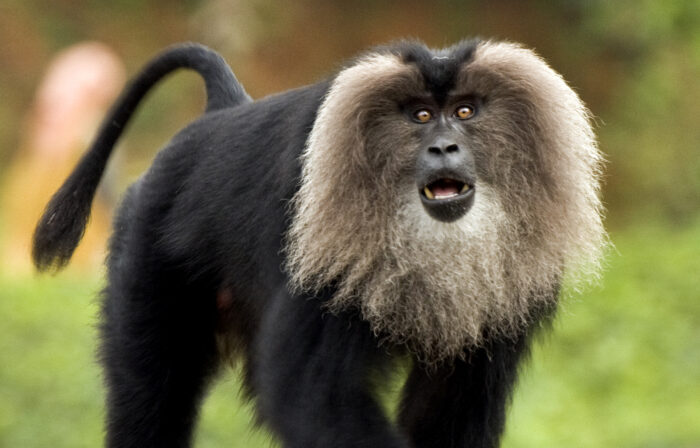The Lion Tailed Macaque (Macaca silenus) is an old world monkey native to the western ghats of Southern India
Old World monkey is the common English name for a family of primates known taxonomically as the Cercopithecidae
This article will give details about the Lion-Tailed Macaque within the context of the IAS Exam
Characteristics of the Lion-Tailed Macaque
Lion-tailed macaques have black hair. It is easily recognised by its silver-white mane that surrounds the head from the cheeks down to its chin. Its face has no hair and is black in colour. Head to body length is about 61 cm and weighs about upto 10 kg, making it one of the smallest among the macaques species. The black tuft is more prominent in males than females with the tail being about 25 cm in length.
The life expectancy for a wild lion-tailed macaque is 20 years while it is 30 years in captivity.
To know more about Biodiversity in general, visit the linked article.
Behaviour of the Lion-Tailed Macaque
The lion-tailed macaque is diurnal in nature, as in being active solely during daylight hours. Preferring rainforest environments it is a good climber , spending most of its time in the upper reaches of a tropical rainforest. Its habitats consist of rainforest regions of Karnataka, Kerala and Tamil Nadu.
Unlike other macaques, lion-tails avoid humans as much as possible. They form hierarchical groups of about 20 members. These groups fiercely defend their territories with loud cries and if necessary, brawling aggressively.
The diet of the lion-tailed macaque consists of fruits, leaves, buds, and insects. However, they diversify their diets in the event of environmental change or scarcity. They are also known to feed on fruits seeds, shoos, flowers and other parts of non indegenous plants.

Conservation of Lion-Tailed Macaque
As per the assessment carried out by the International Unit for Conservation of Nature (IUCN) it was reported that 3000-3500 of the lion-tailed macaque population was dispersed in Kerala, Tamil Nadu and Karnataka. Its red list categories it as ‘endangered ‘.
Their population range is becoming significantly limited due to spread of agriculture and commercial farming for tea, coffee. Construction of new dams and irrigational facilities are also a factor in their decline.
Despite conservation efforts, habitat loss remains the key component in their population decline.
For notes on UPSC Environment and Ecology, visit the linked article.
The Silent Valley National Park in Kerala has the largest population of lion-tailed macaques in South India. It was part of the Save Silent Valley project launched in 1973, which sought to protect the region from development projects and in turn the remaining population of lion-tailed macaques.
Lion-Tailed Macaque- Download PDF Here
Frequently Asked Questions Related to Lion-Tailed Macaque
What are the other sanctuaries of the Lion-Tailed macaque?
Some of the sanctuaries for lion-tailed macaque are as follows:
Neyyar Wildlife Sanctuary
Peppara Wildlife Sanctuary
Shendurney Wildlife Sanctuary
Periyar Tiger Reserve
Aralam Wildlife Sanctuary.
What are the additional threats to the lion-tailed macaque?
What are the adaptive features of Lion-tailed macaque?
For more information about upcoming Government Exams, visit the linked article. More exam-related preparation materials will be found through the links given below:
Related Links

Comments